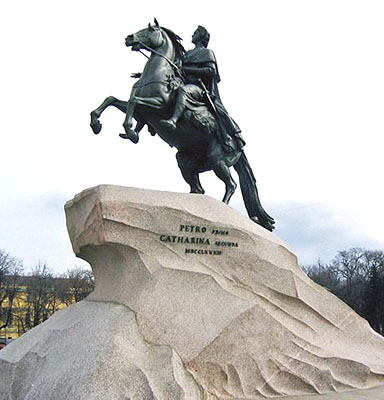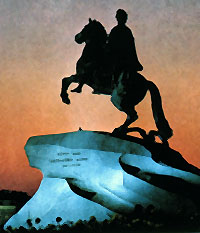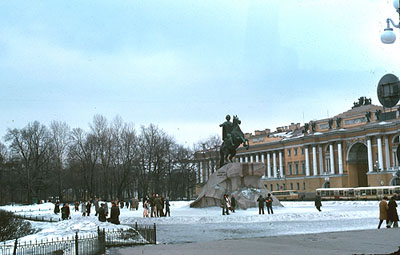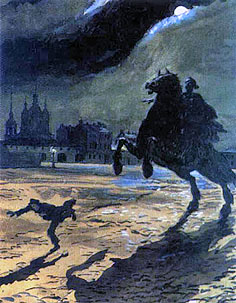
The equestrian statue of Peter the Great, the "Bronze Horseman," was created by the famous French sculptor Étienne-Maurice Falconet (1716-1791)--the head of Peter was designed by Falconet's pupil and mistress, Marie Colot. Falconet moved to Russia in 1766, having been recommended to Catherine the Great by Denis Diderot. Falconet worked on the sculpture until his return to France in 1778; the sculpture was finally unveiled in St. Petersburg in 1782. The Bronze Horseman site provides a really good explanation of the making of the monument. For example, I did not know that Peter himself used to stand on the block of granite, "thunder rock," used as the base.

The pedestal is made of a single piece of red granite in the shape of a wave. (Some commentators call it a "cliff.) From the top, Peter shows the way to the West for Russia, while his horse steps on a snake, which represents the enemies of Peter and his reforms (or Sweden, the foe in the Great Northern War). The monument was built by order of Catherine the Great to make some connection to Peter (since she had absolutely none). The inscription on one side of the granite pedestal reads in Latin (Petro Primo Catarina Secunda 1782) and in Russian on the other side (Петру Перьвому Екатерина Вторая 1782), "To Peter the First from Catherine the Second." The statue has three points of support (the two hind legs of the horse and the horse's tail); It is a really powerful monument.
According to legend, enemy forces would never capture
St. Petersburg while the "Bronze Horseman" still stood as protector. During
World War II the statute was protected with sand bags and a wooden
shelter and survived intact. See also, Professor Blois' comments on Falconet and the Bronze Horseman.


Well, the statue is one thing, but you should always
view the work in combination with another pillar of Russian culture, Aleksandr Pushkin's
poem, The Bronze Horseman (Медный всадник)
written in 1833, which is what really gave the sculpture its name "the Bronze Horseman." In the poem, Pushkin
described the fate of Evgenii and his loved ones
during a flood of the Neva River. Pushkin used the image of the flood to
show the conflict between the interests of the Russian state,
represented by the Peter statue, and the immediate needs of the people
for safety. The home of Evgenii's fiancée on one of the city's islands
is washed
away, and the inhabitants drowned. Evgenii, driven almost mad
with grief, curses the Bronze Horseman statue. Suddenly, the statue
breaks free from
its pedestal and chases Evgenii to his death.

"Illustration of the Bronze
Horseman breaking free from his pedestal to trample down Evgenii" by
Alexandre Benois (Александр Бенуа, 1870–1960).
Benois was one of
Russia's most important artists, a talented illustrator, set designer,
art theorist and publicist. In 1897, he met Sergei Diaghilev and
Leon Bakst who together joined forces to publish the art magazine, Mir
iskusstva (world of art).